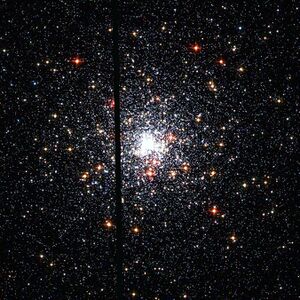Astronomy:NGC 6624
From HandWiki
Short description: Globular cluster located in the constellation Sagittarius
| NGC 6624 | |
|---|---|
 The globular cluster NGC 6624. Credit Hubble Space Telescope | |
| Observation data (J2000 epoch) | |
| Constellation | Sagittarius |
| Right ascension | 18h 23m 41s |
| Declination | −30° 21′ 39″ |
| Distance | 25.8 ± 1.1 kly (7.91 ± 0.34 kpc) |
| Apparent magnitude (V) | 7.6 |
| Apparent dimensions (V) | 8.8 arcminutes[1] |
| Physical characteristics | |
| Metallicity | = -0.56 ± 0.27[2] dex |
| Other designations | ESO 457-11, GCl 93, CD−30 15631, CPD−30 5486, HD 168943[3] |
NGC 6624 is a globular cluster in the constellation Sagittarius. It was discovered on 24 June 1784 by the astronomer William Herschel. It is given an apparent magnitude of 7.6 to 8.5.[4] Six pulsars are known in NGC 6624. The first of these to be discovered was PSR J1823-3021A. This globular cluster also contains 4U 1820-30, a low-mass X-ray binary with an orbital period of only 11.5 minutes.
NGC 6624 is visible as a hazy spot with a small telescope, and appears as a star-like object with binoculars. Its core appears significantly condensed.[1] It is located 0.8 degrees southeast of the star Delta Sagittarii,[5] and is about 1.17 kpc (3.8 kly) from the Galactic Center.[2]

References
- ↑ 1.0 1.1 O'Meara, Steve (2007). Steve O'Meara's Herschel 400 Observing Guide. Cambridge: Cambridge University Press. pp. 236. ISBN 978-0-521-85893-9. https://books.google.com/books?id=Nyh9fAC_tpIC&pg=PA236.
- ↑ 2.0 2.1 Sofue, Yoshiaki (1998-08-31). The Central Regions of the Galaxy and Galaxies. Netherlands: Kluwer Academic Publishers. pp. 37. ISBN 978-0-7923-5061-3. https://books.google.com/books?id=ZDU6X1sYMlAC&pg=PA37.
- ↑ "NGC 6624". SIMBAD. Centre de données astronomiques de Strasbourg. http://simbad.u-strasbg.fr/simbad/sim-basic?Ident=NGC+6624.
- ↑ It is given a diameter of 6 to 8.5 arcminutes, and class VI with stars magnitude 14 and dimmer. It is less than a degree southeast of star Delta Sagittarii. O'Meara, Stephen James (2007). Deep Sky Companions: Hidden Treasures. Cambridge University Press. pp. 452. ISBN 978-1-139-46373-7. https://books.google.com/books?id=a6VY0Q1zsJoC&pg=PA452.
- ↑ Bakich, Michael E. (2010). 1001 Celestial Wonders to See Before You Die: The Best Sky Objects for Star Gazers. Patrick Moore's Practical Astronomy Series. Springer. pp. 249. doi:10.1007/978-1-4419-1777-5. ISBN 978-1-4419-1776-8. https://books.google.com/books?id=qEhpS7d5ZdAC&pg=PA476.
- Robert Burnham, Jr, Burnham's Celestial Handbook: An observer's guide to the universe beyond the solar system, vol 3, p. 1557
External links
 |

